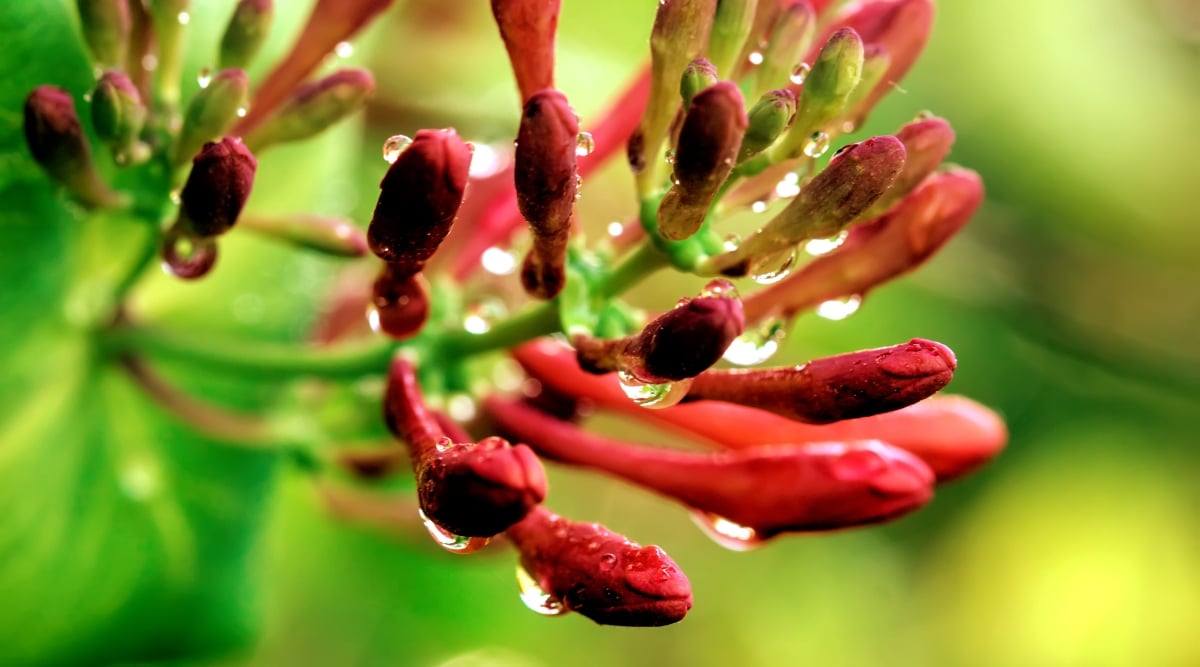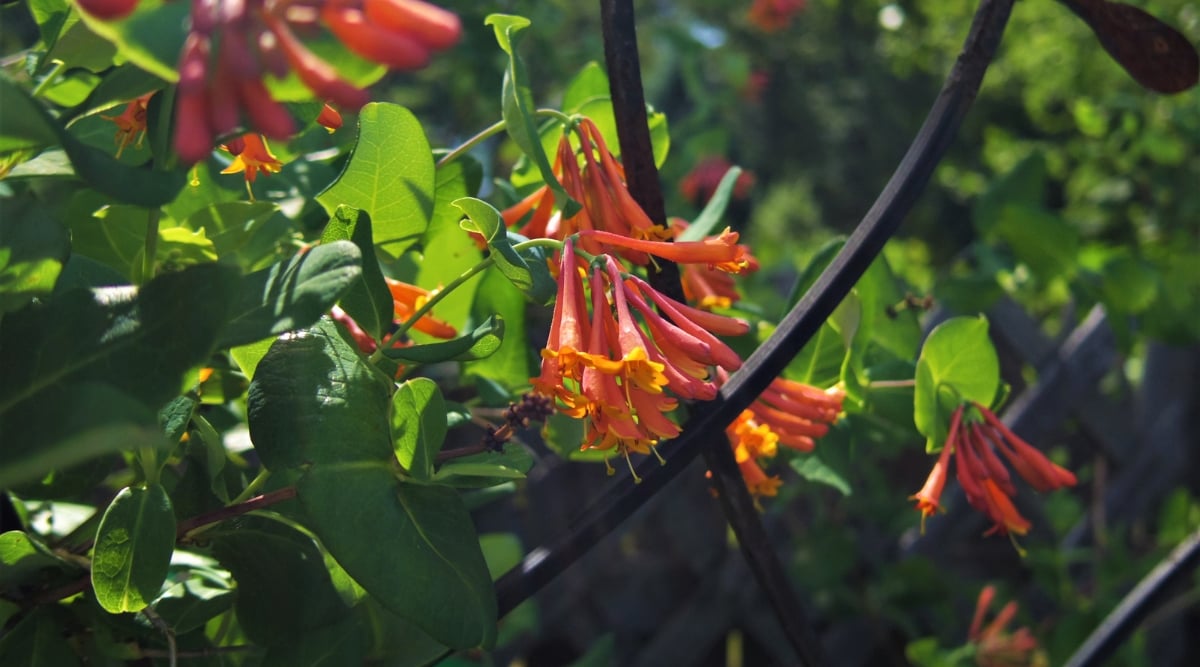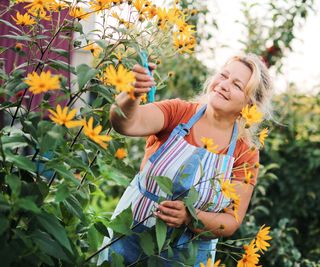Coral honeysuckle, or trumpet honeysuckle (Lonicera sempervirens), is an ornamental vine native to the eastern and southeastern United States. It grows naturally in moist open woodlands, along streamsides, and at damp woodland edges. It prefers at least a little bit of shade.
This beautiful, low-maintenance climbing vine loves to twine its way up a trellis, fence, or even small trees. The long stems are lined with opposite pairs of simple, slightly leathery leaves.
In the late spring or early summer, it blooms with bright red, narrow, trumpet-like flowers that are yellow inside. The flowers grow in loose clusters and are very showy but not fragrant. Attractive bright red fruits develop after flowering and linger on the vines well into the fall.
It’s also an excellent plant for wildlife. Hummingbirds especially adore the tubular flowers. Native bees and other pollinators also visit the flowers as a valuable nectar source. Fruit-eating birds will come to enjoy the berries.
It is a larval host plant for the spring azure butterfly and the beautiful clearwing moth. If you plant it in your yard, you provide a nutritious buffet for many animals.
If you are familiar with the invasive Japanese honeysuckle and are wary of planting an invasive vine, you’re in luck. This native species thrives where you plant it but does not spread aggressively. Coral honeysuckle is a well-behaved perennial woody vine that makes a great choice for your native plant garden, hummingbird garden, or cottage garden landscape.
Now, let’s dig into the growing details!
Plant Overview
| | |
Plant Natural History
 Coral honeysuckle exhibits good salt tolerance, making it suitable for coastal areas.
Coral honeysuckle exhibits good salt tolerance, making it suitable for coastal areas.
Native to the southern and eastern United States, you’ll find this vine in moist, open woodlands, along roadsides, and stream banks. Without nearby taller vegetation, it will spread along the ground. It has a good tolerance to salt and does well in coastal areas.
It is evergreen in the warmer parts of its range, while it becomes deciduous in colder climates. It blooms most profusely from late spring into summer. After a pause in flowering, it may have a secondary, less vigorous blooming phase later in mid-summer. The flowers then give way to small, oval-shaped, bright red fruits that persist into fall.
Because this plant is quite popular with gardeners, several cultivars are available with slight variations in flower color and growth patterns. Unlike the invasive Japanese honeysuckle, this native vine is not invasive, nor is it an aggressive competitor. It is, however, a very valuable wildlife food plant.
Propagation
If you wish to propagate your existing plant, there are several ways to try. The simplest is by taking stem cuttings in the spring or summer. You can also try growing plants from seed, but this is less reliable and takes more time.
Seed
 You can extract the seeds from these fruits if desired, but there are other propagation methods as well.
You can extract the seeds from these fruits if desired, but there are other propagation methods as well.
If you want to grow from seed, wait until the plants have developed mature red fruits and harvest a few of these fruits. You do not need to remove the seeds from the fruits immediately, but you can if you want to.
First, place the seeds or fruits in the freezer for at least 90 days for cold stratification to signal them to germinate. After freezing for 90 days, separate the seeds from the fruits, sow the seeds on the soil surface, and keep the soil warm and moist until the seeds germinate. Allow your seedlings to grow several inches tall before transplanting them.
Stem Cuttings
 One simple propagation method is to take stem cuttings in late spring or early summer.
One simple propagation method is to take stem cuttings in late spring or early summer.
One of the easiest ways to propagate is by taking a stem cutting. Take softwood or semi-hardwood cuttings in late spring or early summer. Cut a five or six-inch section of fresh vine tip. You can root this in water or dip it in rooting hormone before planting it in fresh, moist soil.
After several weeks in soil or a few weeks in water that you replace with fresh water regularly, the vine will start to develop roots. You can successfully transplant your stem cutting when the roots have grown several inches long.
Planting
 Ensure your soil is well-drained, loose, and nutrient-rich.
Ensure your soil is well-drained, loose, and nutrient-rich.
You may have purchased a young plant from a garden center or propagated a young plant from seed or a cutting. Eventually, you will need to transplant it outside into its permanent home. These plants don’t like to be disturbed once established, so choose a long-term spot.
The ideal time for planting outside is in the spring or fall. Choose a cool and overcast day to minimize transplanting stress on your plant.
Prepare your soil by loosening it and ensuring it is rich and well-drained. Dig a hole deep enough to accommodate your plant’s roots and carefully transfer your young plant into the hole. Re-fill the hole with fresh soil and water the plant well. Keep your new plant well-watered for the first few weeks to help it get established.
How to Grow
Coral honeysuckle is an easy-to-grow vine. In addition to providing your plant with ideal sunlight, water, and soil conditions, you will also want to provide some structural support.
These are twining, climbing vines that want to grow vertically. Plant near a trellis, fence, arbor, or anything they can grow up and over. Make sure the structural support is sturdy. A thin, flimsy trellis will not be enough to support a fully mature plant.
Sunlight
 For optimal performance, plant in a spot with full sun to partial shade.
For optimal performance, plant in a spot with full sun to partial shade.
Full sun to partial shade is optimal. Ideally, give your plant a location that receives between 2 and 8 hours of direct sunlight daily.
Water
 Extra watering is usually unnecessary if you plant it in suitable soil.
Extra watering is usually unnecessary if you plant it in suitable soil.
Coral honeysuckle prefers moist soil but will tolerate periods of drought once it is established. While it flowers best with regular moisture, it can put down very deep roots into the soil, which helps it access moisture in the lower soil profile. It will also tolerate brief periods with wet soil conditions.
Soil
 Aim for a soil pH ranging from neutral to slightly acidic, typically around 5.5 to 7.
Aim for a soil pH ranging from neutral to slightly acidic, typically around 5.5 to 7.
Give these plants organically rich, moist, well-drained soil. The soil pH should be neutral to slightly acidic – between 5.5 and 7 is generally good.
Climate and Temperature
 The southeastern United States has ideal natural weather conditions for this vine.
The southeastern United States has ideal natural weather conditions for this vine.
Coral honeysuckle loves the natural weather conditions of the southeastern United States. Warm summers and mild winters produce very healthy and vigorously growing plants. It is hardy in USDA zones 4 – 9.
Fertilizer
 Fertilization can hinder these plants, leading to lush foliage but no flowers.
Fertilization can hinder these plants, leading to lush foliage but no flowers.
Fertilization isn’t necessary and can be counter-productive for these plants. Fertilizers will encourage them to develop more foliage without producing any flowers. Normally, an annual application of compost at the plant’s base is plenty to keep it going.
Pruning
 If you choose to prune, do so after the flowering period.
If you choose to prune, do so after the flowering period.
Flowers develop on fresh new growth. You don’t have to prune. You can simply allow them to grow and ramble naturally. However, If you do want to prune, wait until after flowering.
Mulch
 To maintain the soil moisture, mulching is recommended.
To maintain the soil moisture, mulching is recommended.
Because these vines like consistently moist soil, mulch around your plant to help retain soil moisture. Use an organic, biodegradable mulch, such as shredded leaf mulch, wheat straw, or bark mulch. Refresh the mulch every year or two when it has decayed.
Garden Design
 The plant will adapt to its surroundings and can twine around nearby structures.
The plant will adapt to its surroundings and can twine around nearby structures.
Coral honeysuckle is an ornamental native vine you can appreciate in your home landscape. This is a fabulous plant to border a native garden, hummingbird garden, or butterfly garden. It grows vigorously but not aggressively, so you won’t need to worry about it taking over your yard.
Avoid planting next to something like a freestanding mailbox or your favorite flowering shrub. While they aren’t aggressive, they are persistent and will take any opportunity to climb up.
If you don’t provide a climbing structure, it will sprawl along the ground and make a good ground cover. No matter where you plant it, you will want to give it enough space. Each long stem can grow between 10 and 20 feet long.
A mature vine can grow into an attractive tangle of vegetation, providing dense cover for nesting birds, abundant flowers for pollinators, and a profusion of color for you to enjoy. Once planted and established, it should not be moved, so make sure you plant it where you want it. Grow it with some other native wildflowers for a variety of pollinator-friendly plants and a succession of blooming flowers.
Varieties
Several cultivars have variations in flower color and size. Any of these varieties will attract hummingbirds and pollinators and provide you with a beautiful garden plant.
‘Alabama Crimson’
 This cultivar has striking crimson-red flowers with yellow centers.
This cultivar has striking crimson-red flowers with yellow centers.
‘Alabama Crimson’ is a cultivar displaying bright crimson-red flowers with yellow centers. The leaves are an attractive dark blue-green shade. This variety blooms primarily in the springtime and can grow to 20 feet long.
‘Cedar Lane’
 This particular cultivar features stunning elongated red tubular flowers with yellow interiors.
This particular cultivar features stunning elongated red tubular flowers with yellow interiors.
‘Cedar Lane’ has glorious elongated bright red tubular flowers with yellow insides. It can grow to 20 feet long. This cultivar blooms primarily in the spring but may have a lighter reblooming from mid-summer into early fall.
‘John Clayton’
 While it predominantly blossoms in spring, ‘John Clayton’ will also produce flowers during the summer.
While it predominantly blossoms in spring, ‘John Clayton’ will also produce flowers during the summer.
‘John Clayton’ is a naturally occurring hybrid discovered in Virginia. It has solid yellow flowers and plenty of bright red berries. This variety is a bit more compact, growing to about 12 feet long. It blooms most prolifically in the spring but will rebloom in the summer.
Lonicera flava
 Consider Lonicera flava as an alternative species in regions with rocky, well-drained soils.
Consider Lonicera flava as an alternative species in regions with rocky, well-drained soils.
Lonicera flava is a similar but related species with bright yellow-orange flowers. It is native to the southeastern United States and is more of a mountain-loving plant, preferring more rocky, well-drained soils. It can grow up to 20 feet long.
‘Major Wheeler’
 This rapid-growing variety consistently flowers throughout the majority of the growing season.
This rapid-growing variety consistently flowers throughout the majority of the growing season.
‘Major Wheeler’ sports bright red-orange flowers that are hard to miss. It blooms for a long period, typically flowering non-stop during most of the growing season. This variety is fast-growing and can reach up to 20 feet long.
‘Sulfurea’
 The ‘Sulfurea’ variety stands out due to its stunning bright yellow blossoms.
The ‘Sulfurea’ variety stands out due to its stunning bright yellow blossoms.
‘Sulfurea’ is notable because it has beautiful bright yellow flowers. This variety blooms from late spring into early summer. It is more compact than the native species, generally less than 12 feet long. Wildlife Value
Pests and Diseases
This hardy plant is generally unbothered by pests or diseases. You may occasionally see some aphids or powdery mildew, but these encounters are rare and generally resolve without major damage to your plant.
Aphids
 These sap-sucking pests may occasionally appear on new spring growth.
These sap-sucking pests may occasionally appear on new spring growth.
Aphids are small insects that feed on plant juices. They will sometimes show up on fresh spring growth. If you see aphids gathering in clusters on your plant, spray them with some insecticidal soap or squirt them with a few jets of water to dislodge them from their feeding places. This is usually enough to discourage them from becoming a bigger issue.
Powdery Mildew
 To stop its spread, trim off any vine segments with a visibly powdery-looking fungal coating on the leaves.
To stop its spread, trim off any vine segments with a visibly powdery-looking fungal coating on the leaves.
If you notice a grayish-white powdery coating forming on the leaves, it is probably a case of powdery mildew. This fungal infection loves moist, humid areas with poor air circulation.
It is not usually a problem for these plants, and a minor infection won’t cause any lasting damage. Prune off any obvious powdery mildew to prevent further spread to other portions of your vine or to other plants.
Frequently Asked Questions
You can successfully grow these vines in a sturdy, durable raised bed or large container. Ensure that you can keep the soil relatively moist. Use mulch around your plant and water it anytime you aren’t receiving regular rainfall. The root system is extensive, however, so if you have a location where you can plant it permanently, that would be the most ideal situation. Consider a dedicated raised bed or a specific long-term location for your coral honeysuckle.
If you are growing a plant from seed or from a cutting, it should start to bloom within two years. If your plant is older than this and still isn’t blooming, there are a couple of reasons why this might happen. If you are fertilizing, the fertilizer encourages more leaf growth at the expense of flowering. After you stop fertilizing, it should resume flowering the following year. If you are growing in complete shade, it may not be getting enough sunlight to produce flowers.
Yes, absolutely. There’s no need to prune. These plants do extremely well without pruning.
However, if you notice a dead stem, you can prune that off. If your plant has grown up something that it shouldn’t, you can prune the offending stem. You can also prune to keep your plant smaller and more manageable. But any vining parts that are healthy and growing well do not need to be pruned. They will continue to grow and flower each year, becoming increasingly bushy.
Final Thoughts
Coral honeysuckle is a beautiful native plant that can be easily incorporated into your home garden. As long as you can provide a plot for a vigorous vine that can grow into the space of a medium-sized shrub, you will have a spectacular and low-maintenance flowering plant to enjoy. The hummingbirds and pollinators will also enjoy your honeysuckle, and you will know that you’re providing a good food source for the resident wildlife. Give it a mostly sunny spot with moist soil, and then sit back, relax, and enjoy the show!




